The LED Paradox: How Light Pollution Challenges Experts to Reconsider Sustainable Lighting
Abstract
1. Introduction
2. A Transdisciplinary Approach: Light Pollution—A Global Discussion
3. Results: Ambivalent Views on LED Lighting
3.1. “Cheaper, More Blue and Brighter”: LEDs Contribute to Light Pollution
3.2. “If Correct CCT and Good Design”: LEDs Reduce Light Pollution
4. Discussion: Sustainable LED Visions, Unsustainable Lighting Practices?
5. Conclusions: The Dilemma Behind the LED Paradox
Supplementary Materials
Author Contributions
Funding
Acknowledgments
Conflicts of Interest
Appendix A
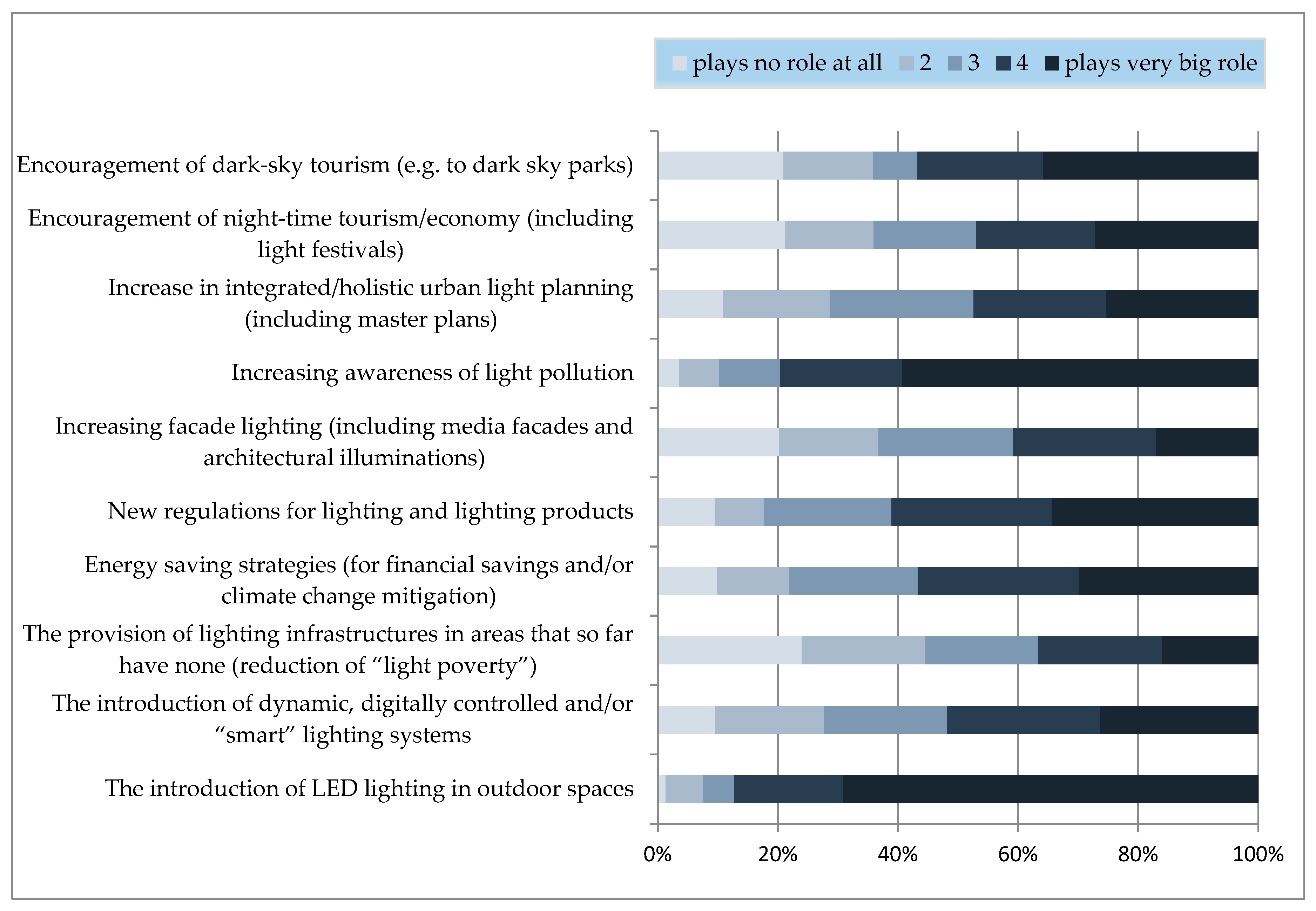
References
- European Commission. Digital Agenda: Commission Consults On Massive Expansion Of Led Lighting In Europe; European Commission—Press Release: Brussels, Belgium, 15 December 2011; Available online: http://europa.eu/rapid/press-release_IP-11-1554_en.htmb (accessed on 30 September 2019).
- European Commission. Directorate-General Communications Networks Contents & Technology. In Lighting the Cities. Accelerating the Deployment of Innovative Lighting in European Cities; EU Task Force on Solid State Lighting for Cities: Brussels, Belgium, June 2013. [Google Scholar]
- US Department of Energy. Outdoor Lighting. Office of Energy Efficiency and Renewable Energy. Available online: https://www.energy.gov/eere/slsc/outdoor-lighting (accessed on 30 September 2019).
- The World Bank. Republic of India Energy-Efficient Urban Street Lighting. In Energy-Efficient Street Lighting—Implementation and Financing Solutions; The World Bank: Washington, DC, USA, 2015; Volume report No: AUS7490; Available online: http://www.esmap.org/sites/esmap.org/files/DocumentLibrary/India%20EE%20Street%20Lighting%20Implementation%20and%20Financing%20(P149482)%20June%2027%202015_Optimized.pdf (accessed on 30 September 2019).
- Wright, M. Outdoor Lighting: China leads in LED street light deployment. LED Magazine. 12 October 2012. Available online: http://ledsmagazine.com/news/7/10/12 (accessed on 30 September 2019).
- Longcore, T.; Rich, C. Ecological light pollution. Front. Ecol. Environ. 2004, 2, 191–198. [Google Scholar] [CrossRef]
- American Medical Association (AMA). Report of the Council on Science and Public Health on Human and Environmental Effects of Light Emitting Diode (LED) Community Lighting; Presented By Luis J. Kraus, MD, Chair; American Medical Association (AMA): Chicago, IL, USA, 2016. [Google Scholar]
- Gaston, K.J.; Visser, M.E.; Hölker, F. The biological impacts of artificial light at night: The research challenge. Philos. Trans. R. Soc. Lond. B Biol. Sci. 2015, 370, 1–6. [Google Scholar] [CrossRef] [PubMed]
- Spoelstra, K.; van Grunsven, R.H.; Donners, M.; Gienapp, P.; Huigens, M.E.; Slaterus, R.; Berendse, F.; Visser, M.E.; Veenendaal, E. Experimental illumination of natural habitat—An experimental set-up to assess the direct and indirect ecological consequences of artificial light of different spectral composition. Philos. Trans. R. Soc. Lond. B Biol. Sci. 2015, 370, 20140129. [Google Scholar] [CrossRef]
- US Department of Energy. True Colors. Leds and The Relationship Between Cct, Cri, Optical Safety, Material Degradation, and Photobiological Stimulation; US Department of Energy: Washington, DC, USA, October 2014.
- European Commission. Ecological Effects Of Light Pollution—Final Project Report. 2017. Available online: https://cordis.europa.eu/project/rcn/98090/reporting/en, last access 2019-30 (accessed on 30 September 2019).
- European Commission. Final Opinion On Potential Risks To Human Health Of Light Emitting Diodes (LEDs). Scientific Committee on Health. 2018. Available online: https://ec.europa.eu/health/sites/health/files/scientific_committees/scheer/docs/scheer_o_011.pdf (accessed on 30 September 2019).
- Poole, M.S.; Van de Ven, A.H. Using paradox to build management and organization theories. Acad. Manag. Rev. 1989, 14, 562–578. [Google Scholar] [CrossRef]
- Gross, M. The Paradox of the Unexpected: Normal Surprises and Living With Nonknowledge. Environ. Sci. Policy Sustain. Dev. 2019, 61, 20–25. [Google Scholar] [CrossRef]
- Brundtland, G.; Khalid, M.; Agnelli, S.; Al-Athel, S.; Chidzero, B.; Fadika, L.; Hauff, V.; Lang, I.; Shijun, M.; de Botero, M.M. Our Common Future; Brundtland Rep.; United Nations: New York, NY, USA, 1987. [Google Scholar]
- Lundvall, B.-A.K. The Learning Economy And The Economics Of Hope; Anthem Press: London, UK, 2016. [Google Scholar]
- Rip, A.; Kemp, R. Technological Change; Battelle Press: Columbus, OH, USA, 1998. [Google Scholar]
- Schulte-Römer, N.; Dannemann, E.; Meier, J. Light Pollution—A Global Discussion; Helmholtz-Centre for Environmental Research GmbH—UFZ: Leipzig, Germany, 2018; Available online: http://www.ufz.de/index.php?en=20939&ufzPublicationIdentifier=21131 (accessed on 30 September 2019).
- Dannemann, E. Bridging the Gap Between Lighting Design And Other Disciplines. 2019. Available online: studiodannemann.com (accessed on 30 September 2019).
- Meier, J. By Night. An Investigation into Practices, Policies and Perspectives on Artificial Outdoor Lighting. Ph.D. Thesis, Technische Universität Berlin, Berlin, Germany, 2019. [Google Scholar] [CrossRef]
- Schulte-Römer, N. Innovating in Public. The Introduction of LED Lighting in Berlin and Lyon. Ph.D. Thesis, Technical University Berlin, Berlin, Germany, 2015. [Google Scholar] [CrossRef]
- Schulte-Römer, N.; Meier, J.; Dannemann, E.; Söding, M. Lighting Professionals versus Light Pollution Experts? Investigating Views on an Emerging Environmental Concern. Sustainability 2019, 11, 1696. [Google Scholar] [CrossRef]
- Mayring, P. Qualitative Content Analysis: Theoretical Foundation, Basic Procedures And Software Solutions. Klagenfurt, 2014. Available online: https://nbn-resolving.org/urn:nbn:de:0168-ssoar-395173 (accessed on 30 September 2019).
- R Development Core Team. R: A Language And Environment For Statistical Computing; R Foundation for Statistical Computing: Vienna, Austria, 2008; Available online: https://www.r-project.org/ (accessed on 30 September 2019).
- Aubé, M.; Roby, J.; Kocifaj, M. Evaluating potential spectral impacts of various artificial lights on melatonin suppression, photosynthesis, and star visibility. PLoS ONE 2013, 8, e67798. [Google Scholar] [CrossRef]
- Aubé, M. Physical behaviour of anthropogenic light propagation into the nocturnal environment. Philos. Trans. R. Soc. B Biol. Sci. 2015, 370. [Google Scholar] [CrossRef]
- Bierman, A. Will switching to LED outdoor lighting increase sky glow? Lighting Res. Technol. 2012, 44, 449–458. [Google Scholar] [CrossRef]
- Kinzey, B.; Perrin, T.E.; Miller, N.J.; Kocifaj, M.; Aubé, M.; Lamphar, H.S. An Investigation of LED Street Lighting’s Impact on Sky Glow; Pacific Northwest National Laboratory: Richland, WA, USA, 2017.
- Curcio, G.; Piccardi, L.; Ferlazzo, F.; Giannini, A.M.; Burattini, C.; Bisegna, F. LED lighting effect on sleep, sleepiness, mood and vigor. In Proceedings of the 2016 IEEE 16th International Conference on Environment and Electrical Engineering (EEEIC), Florence, Italy, 6–8 June 2016; pp. 1–5. [Google Scholar]
- Brainard, G.C.; Hanifin, J.P.; Greeson, J.M.; Byrne, B.; Glickman, G.; Gerner, E.; Rollag, M.D. Action spectrum for melatonin regulation in humans: Evidence for a novel circadian photoreceptor. J. Neurosci. 2001, 21, 6405–6412. [Google Scholar] [CrossRef]
- Lockley, S.W.; Brainard, G.C.; Czeisler, C.A. High sensitivity of the human circadian melatonin rhythm to resetting by short wavelength light. J. Clin. Endocrinol. Metab. 2003, 88, 4502–4505. [Google Scholar] [CrossRef] [PubMed]
- Longcore, T.; Rodríguez, A.; Witherington, B.; Penniman, J.F.; Herf, L.; Herf, M. Rapid assessment of lamp spectrum to quantify ecological effects of light at night. J. Exp. Zool. A Ecol. Integr. Physiol. 2018, 329, 511–521. [Google Scholar] [CrossRef] [PubMed]
- Donners, M.; van Grunsven, R.H.; Groenendijk, D.; van Langevelde, F.; Bikker, J.W.; Longcore, T.; Veenendaal, E. Colors of attraction: Modeling insect flight to light behavior. J. Exp. Zool. Part A Ecol. Integr. Physiol. 2018, 329, 434–440. [Google Scholar] [CrossRef] [PubMed]
- Longcore, T.; Aldern, H.L.; Eggers, J.F.; Flores, S.; Franco, L.; Hirshfield-Yamanishi, E.; Petrinec, L.N.; Yan, W.A.; Barroso, A.M. Tuning the white light spectrum of light emitting diode lamps to reduce attraction of nocturnal arthropods. Philos. Trans. R. Soc. B Biol. Sci. 2015, 370, 20140125. [Google Scholar] [CrossRef]
- Khan, T.; Bodrogi, P.; Vinh, Q.T.; Winkler, H. LED Lighting: Technology and Perception; John Wiley & Sons: Hoboken, NJ, USA, 2015. [Google Scholar]
- Meier, J.M. Contentious Light: An Analytical Framework for Lighting Conflicts. Int. J. Sustain. Lighting 2018, 20, 62–77. [Google Scholar] [CrossRef]
- Gandy, M. Negative Luminescence. Ann. Am. Assoc. Geogr. 2017, 107, 1090–1107. [Google Scholar] [CrossRef]
- Bijker, W.E.; Hughes, T.P.; Pinch, T.J. The Social Construction of Technological Systems: New Directions in the Sociology and History of Technology; MIT Press: Cambridge, MA, USA, 1987. [Google Scholar]
- Bijker, W.E. Of Bicycles, Bakelites, and Bulbs: Toward a Theory of Sociotechnical Change; MIT Press: Cambridge, MA, USA, 1997. [Google Scholar]
- Oudshoorn, N.; Pinch, T. Introduction: How users and non-users matter. In How Users Matter The Co-Construction of Users and Technology; Oudshoorn, N., Pinch, T., Eds.; MIT Press: Cambridge, MA, USA, 2003; pp. 1–28. [Google Scholar]
- Shove, E. Comfort, Cleanliness and Convenience: The Social Organization of Normality; Berg: Oxford, UK, 2003. [Google Scholar]
- Edensor, T. From Light to Dark: Daylight, Illumination, and Gloom; University of Minnesota Press: Minneapolis, MN, USA, 2017. [Google Scholar]
- Tsao, J.Y.; Waide, P. The world’s appetite for light: Empirical data and trends spanning three centuries and six continents. Leukos 2010, 6, 259–281. [Google Scholar]
- Kyba, C.C.M.; Kuester, T.; Sánchez de Miguel, A.; Baugh, K.; Jechow, A.; Hölker, F.; Bennie, J.; Elvidge, C.D.; Luis, G.; Gaston, K.J. Artificially lit surface of Earth at night increasing in radiance and extent. Sci. Adv. 2017, 3, 1–9. [Google Scholar] [CrossRef]
- Busch, L. Standards: Recipes for Reality; MIT Press: Cambridge, MA, USA, 2011. [Google Scholar]
- Ebbensgaard, C.L. Standardised difference: Challenging uniform lighting through standards and regulation. Urban Stud. 2019. [Google Scholar] [CrossRef]
- Schroer, S.; Kyba, C.; van Grunsven, R.; Celino, I.; Corcho, O.; Hölker, F. Citizen Science To Monitor Light Pollution—A Useful Tool For Studying Human Impacts On The Environment. In Citizen Science: Innovation in open Science, Society and Policy; Hecker, S., Bonney, R., Haklay, M., Hölker, F., Hofer, H., Goebel, C., Gold, M., Makuch, Z., Ponti, M., Richter, A., et al., Eds.; UCL Press: London, UK, 2018; pp. 353–365. [Google Scholar]
- Scott, L.A.; Narboni, R. Lighting. Illumination in Architecture; Revo Media Partners Ltd.: London, UK, 2015; pp. 72–79. [Google Scholar]
- New Perspectives on the Future of Healthy Light and Lighting in Daily Life; Zielinska-Dabkowska, K., Rhode, M.F., Eds.; Callidus. Verlag wissenschaftlicher Publikationen: Wismar, Germany, 2017. [Google Scholar]
- Challéat, S.; Lapostolle, D.; Bénos, R. Consider the darkness. From an environmental and sociotechnical controversy to innovation in urban lighting. J. Urban Res. 2015, 11, 1–17. [Google Scholar] [CrossRef]
- CALiPER. Snapshot Outdoor Area Lighting; Office of Energy Efficiency and Renewable Energy, U.S. Department of Energy: Washigton, DC, USA, 2017; p. 8. Available online: https://www.lightingfacts.com/Library/Content/Snapshot (accessed on 30 September 2019).
- European Commission. Green Public Procurement Criteria for Road Lighting and Traffic Signals. 2019. Available online: https://susproc.jrc.ec.europa.eu/Street_lighting_and_Traffic_signs/whatsnew.html (accessed on 30 September 2019).
- Barantine, J. The European Union Adopts New Guidance On Roadway Lighting Installations. 2019. Available online: https://www.darksky.org/eu-gpp-2018/ (accessed on 30 September 2019).
- ILP—Institution of Lighting Professionals. Guidance Notes for the Reduction of Obtrusive Light; ILP—Institution of Lighting Professionals: Rugby, UK, 2011; Available online: https://www.theilp.org.uk/documents/obtrusive-light/guidance-notes-light-pollution-2011.pdf (accessed on 30 September 2019).
- Ylinen, A.-M.; Tähkämö, L.; Puolakka, M.; Halonen, L. Road lighting quality, energy efficiency, and mesopic design–LED street lighting case study. Leukos 2011, 8, 9–24. [Google Scholar]
- Tähkämö, L.; Halonen, L. Life cycle assessment of road lighting luminaires–comparison of light-emitting diode and high-pressure sodium technologies. J. Clean. Prod. 2015, 93, 234–242. [Google Scholar] [CrossRef]
- Foucault, M. Power/Knowledge: Selected Interviews and Other Writings, 1972–1977 (1st American ed.); Pantheon Books: New York, NY, USA, 1980. [Google Scholar]
- Verhaar, H. Lighting: A driver of the sustainable revolution. Photoniques 2018, 36–41. [Google Scholar] [CrossRef]
- Pottharst, M.; Wukovitsch, F. The Economics of Night-Time Illumination. In Urban Lighting, Light Pollution and Society; Meier, J., Hasenöhrl, U., Krause, K., Pottharst, M., Eds.; Routledge: New York, NY, USA, 2015; pp. 203–223. [Google Scholar]
- Green, J.; Perkins, C.; Steinbach, R.; Edwards, P. Reduced street lighting at night and health: A rapid appraisal of public views in England and Wales. Health Place 2015, 34, 171–180. [Google Scholar] [CrossRef]
- Entwistle, J.; Slater, D. Making space for ‘the social’: Connecting sociology and professional practices in urban lighting design 1. Br. J. Sociol. 2019. [Google Scholar] [CrossRef] [PubMed]
- Manchester, H. Light of Hope—Or Terror? Read. Dig. 1963, 82, 97–100. [Google Scholar]
- US Department of Energy. LED Lighting Forecast, analysis period of 2013 to 2030. Available online: https://www.energy.gov/eere/ssl/led-lighting-forecast (accessed on 30 September 2019).
- PS Market Research. Outdoor Lighting Market Overview. 2019. Available online: https://www.psmarketresearch.com/market-analysis/outdoor-lighting-market (accessed on 30 September 2019).
- Kyba, C.C.M. Is light pollution getting better or worse? Nat. Astron. 2018, 2, 267–269. [Google Scholar] [CrossRef]
- Falchi, F.; Cinzano, P.; Duriscoe, D.; Kyba, C.C.M.; Elvidge, C.D.; Baugh, K.; Portnov, B.A.; Rybnikova, N.A.; Furgoni, R. The new world atlas of artificial night sky brightness. Sci. Adv. 2016, 2, e1600377. [Google Scholar] [CrossRef]
- Challéat, S.; Lapostolle, D. Getting Night Lighting Right. Taking Account of Nocturnal Urban Uses for Better-Lit Cities. Metropolitics 2018. Available online: https://www.metropolitiques.eu/Getting-Night-Lighting-Right.html (accessed on 30 September 2019).
- Stone, T. Designing for Darkness. Urban Nighttime Lighting and Environmental Values; Delft University of Technology: Delft, The Netherlands, 2019. [Google Scholar]
- Leccese, F.; Vandelanotte, V.; Salvadori, G.; Rocca, M. Blue light hazard and risk group classification of 8 W LED tubes, replacing fluorescent tubes, through optical radiation measurements. Sustainability 2015, 7, 13454–13468. [Google Scholar] [CrossRef]
- Behar-Cohen, F.; Martinsons, C.; Viénot, F.; Zissis, G.; Barlier-Salsi, A.; Cesarini, J.; Enouf, O.; Garcia, M.; Picaud, S.; Attia, D. Light-emitting diodes (LED) for domestic lighting: any risks for the eye? Prog. Retin. Eye Res. 2011, 30, 239–257. [Google Scholar] [CrossRef]
- Schulmeister, K.; O’Hagan, J.; Sliney, D.H. Lamp and LED safety–classification vs. realistic exposure analysis. Health Phys. 2019, 105, 74–96. [Google Scholar]
- Beu, D.; Ciugudeanu, C.; Buzdugan, M. Circular Economy Aspects Regarding LED Lighting Retrofit—From Case Studies to Vision. Sustainability 2018, 10, 3674. [Google Scholar] [CrossRef]
- Gossart, C.; Ozaygen, A. Barriers to eco-innovation in the LED sector: A multilevel perspective. SSRN Electron. J. 2016. [Google Scholar] [CrossRef]
- Franz, M.; Wenzl, F.P. Critical review on life cycle inventories and environmental assessments of LED-lamps. Crit. Rev. Environ. Sci. Technol. 2017, 47, 2017–2078. [Google Scholar] [CrossRef]
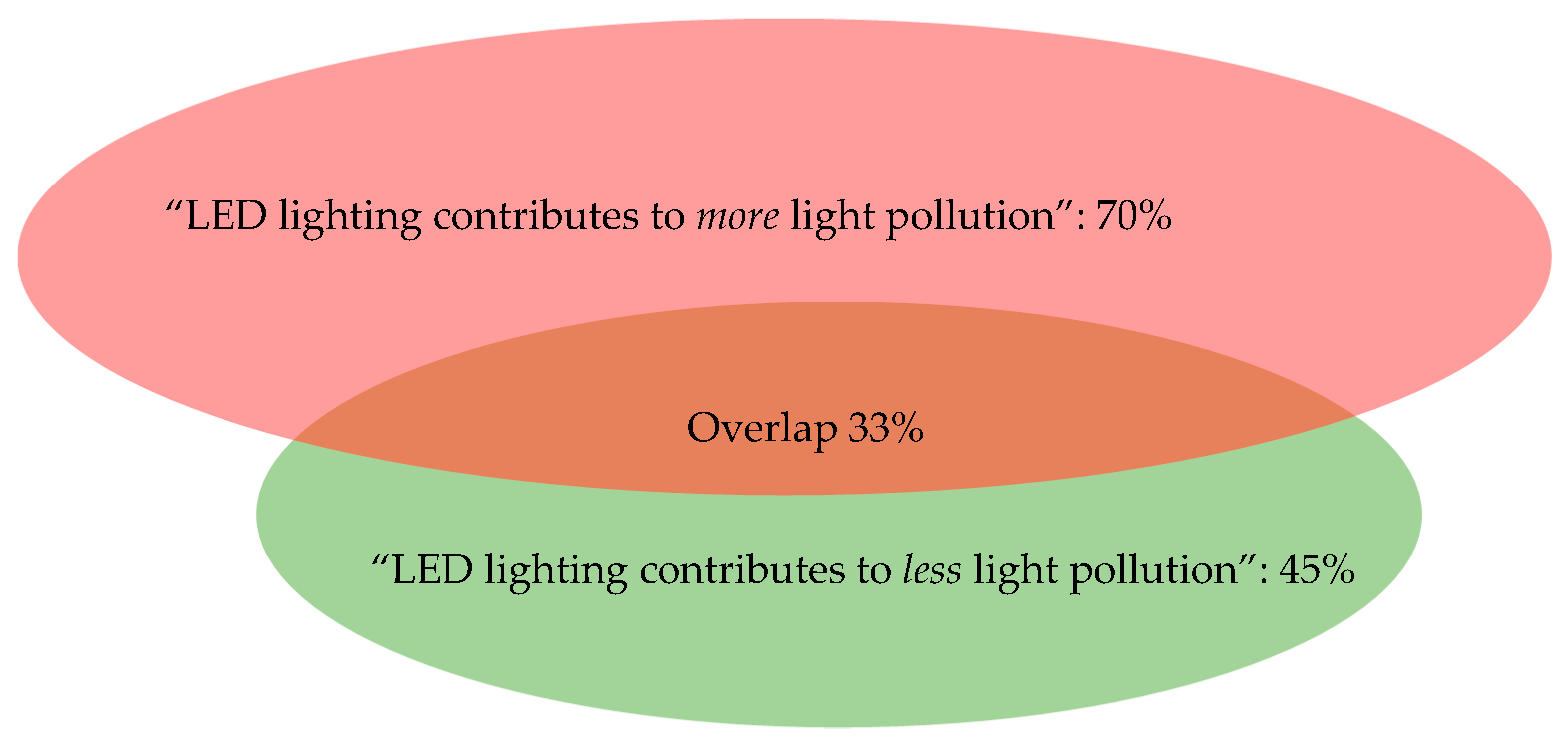
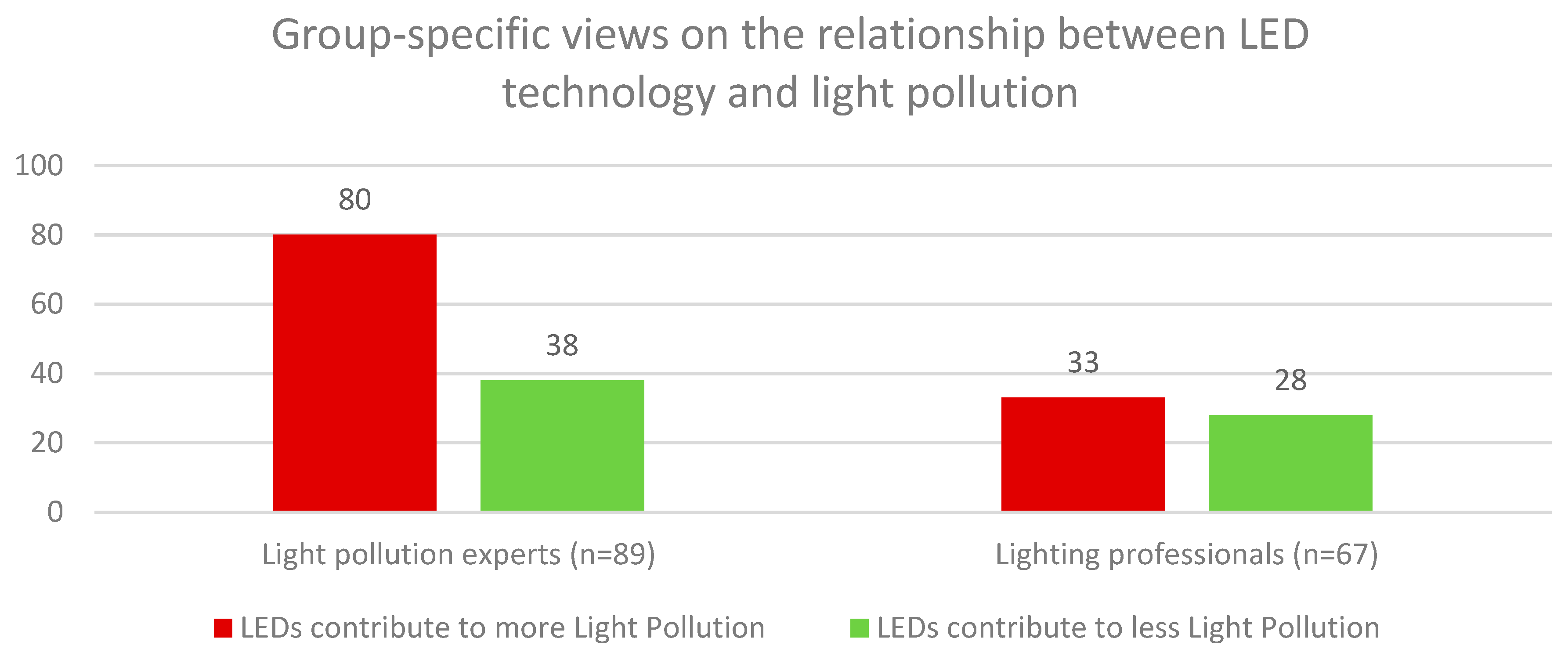
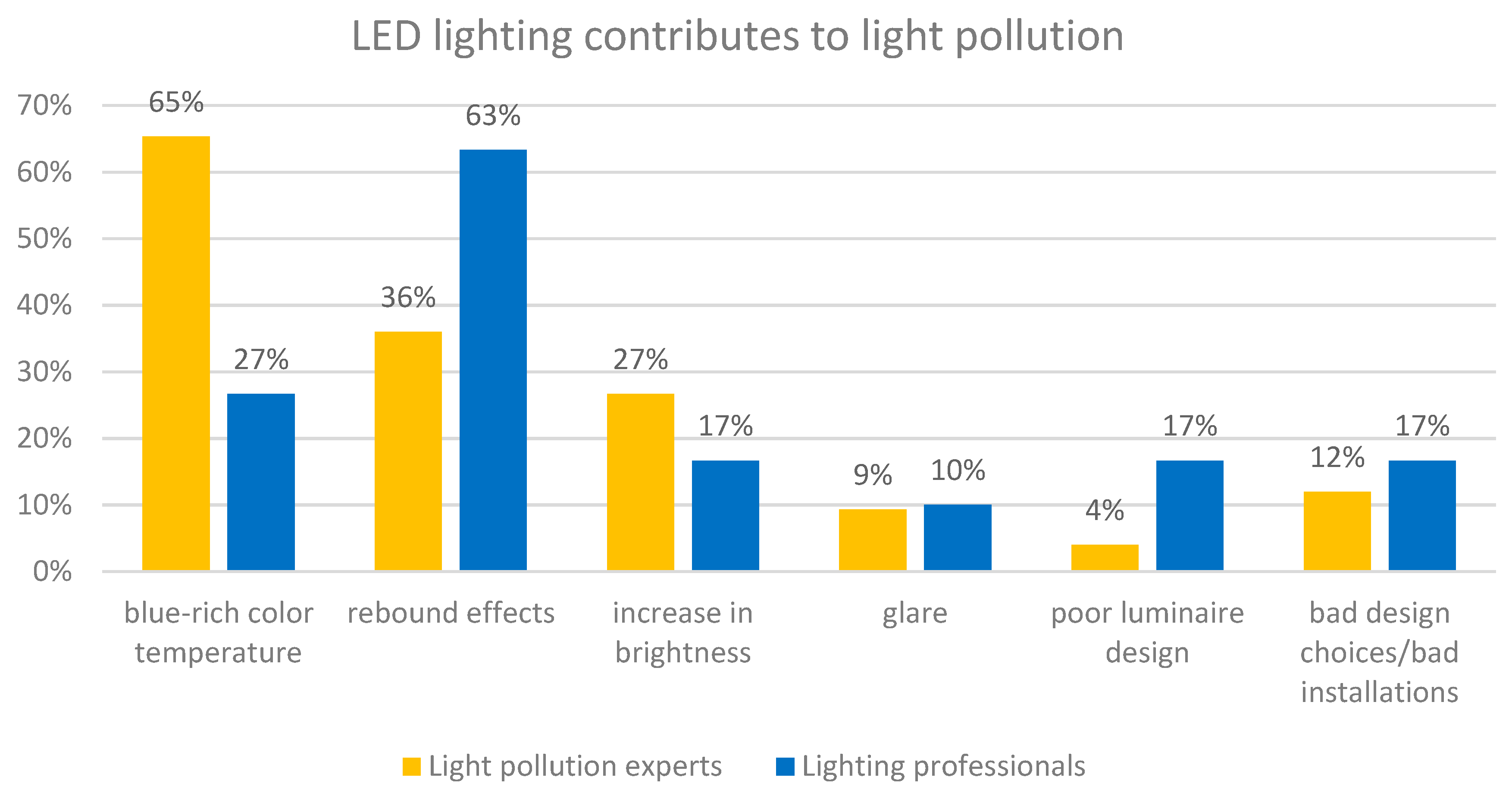
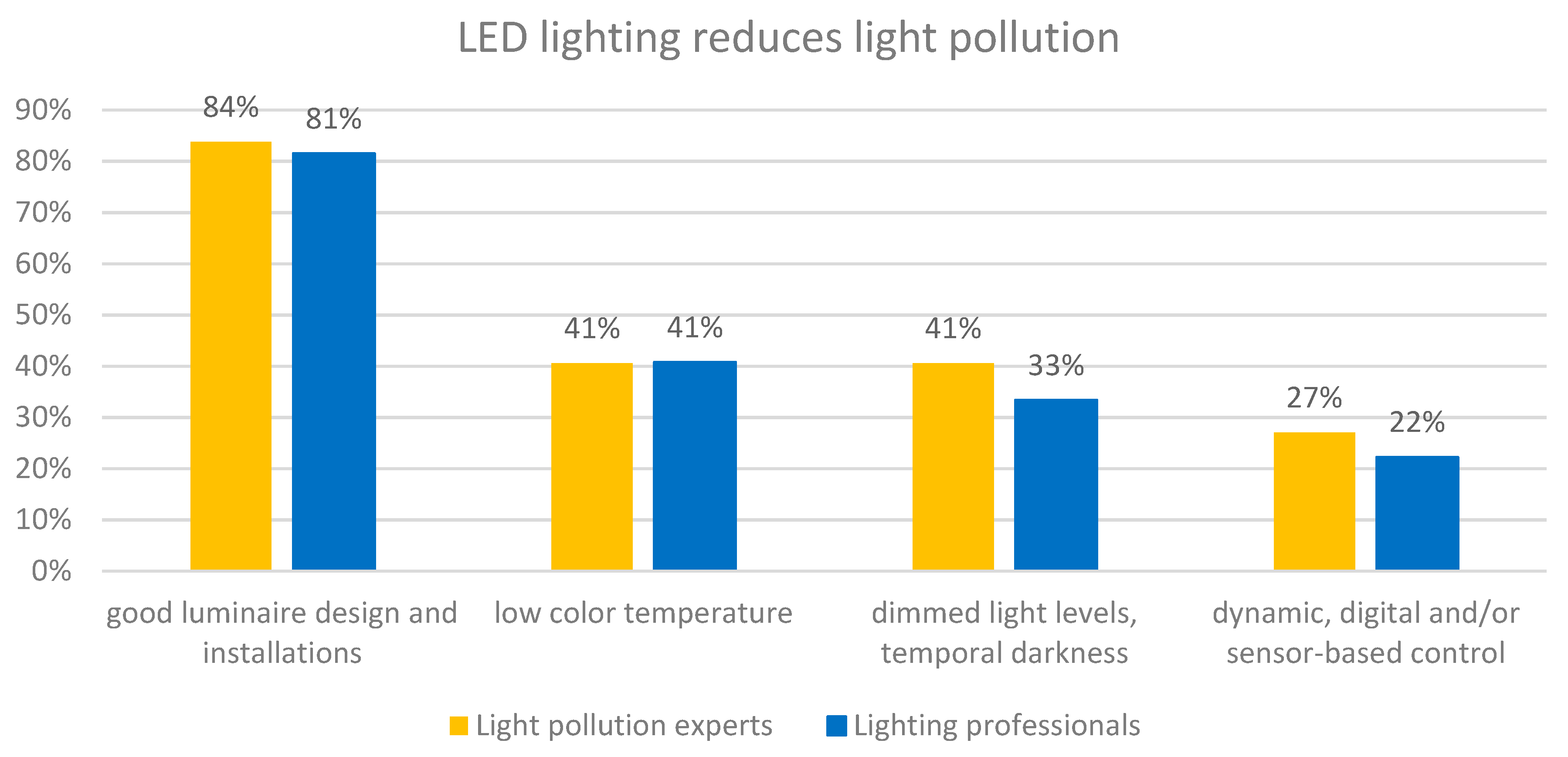
| Code Categories | Exemplary Statements |
|---|---|
| Blue-rich color temperature (54.3%) | “[because] most LED have a large blue light output.” “blue-rich light causes more pollution and has a more deleterious effect on wildlife and the environment” “Increased Rayleigh scattering from short-wave light.” “Blue White light, and no thought of narrow band amber bulbs” |
| Rebound effects (43.8%) | “More fixtures may be installed, due to higher efficiency and lower connected load.” “Due to sinking costs for maintenance more fixtures are installed (rebound effect)” “…overuse of color ‘because we can’” “Because of the so-called rebound effects and the many possible applications of LEDs.” |
| Increase in brightness (23.8%) | “…because of misunderstanding about what lighting levels can be achieved.” “Due to higher lumen/Watt ratios (and unfortunate standards…)” “…much brighter and glary light compared to traditional lighting sources.” |
| Bad design choices, bad installations (13.3%) | “…communities do not care about the real possibilities by dimming them [LEDs].” “Many local authorities use over-bright, too-blue LEDs. Most domestic and commercial exterior lighting is poorly designed, too bright and has little or no information about preventing pollution.” “…LEDs increase light pollution when they are used as replacements for CFL lamps because their higher efficiency is not used to reduce the energy consumption but to increase the level of lightning.” |
| Glare (9.5%) | “…much brighter and glary light compared to traditional lighting sources.” “…intense distribution of light/glare” “It creates… debilitating glare…” “Strong directional project contributes to glare, and can require more installations.” |
| Poor luminaire design (7.6%) | “…the only LED streetlight available here in Brazil so far is 6.400k!” “Illumination levels too high; retrofit are bad and still many unshielded LED will be established.” “Horrible ‘white’ spectrums. Planar wavefront formation, concentrated source surfaces…” |
| Other (7.6%) | “It creates more circadian disruption, debilitating glare and sky glow + is an aesthetic disaster.” “LEDs terrorize my eyes virtually everywhere - in streetlamps, at sports fields, in DRLs, in ceilings, even in some new refrigerators (which have two strips of LEDs).” “NASA photos prove there is more light pollution. My burning retinas also register more light.” |
| Code Categories | Exemplary Statements |
|---|---|
| Good luminaire designs and installations (inseparable) (82.8%) | “Because LEDs are more flexible than other light sources and can bring light only to areas where it is really needed.” “LEDs are key to reducing light pollution: directionality, dimmable, tailored spectrum.” “LEDs can be shielded to reduce light pollution…” “Better inherent shielding directional control in many designs.” |
| Low color temperature (40.6%) | “If having a color temperature < 2700 K. There are orange LEDs with a TCC < 2200 K.” “The option of low-blue-light LED like PC-amber can offer a great combination of the pros of LED while reducing the amount of blue to amounts that are less than HPS.” “…they come in low CCTs for healthier light.” “…PC amber LEDs may give a substantial reduction of LP.” |
| Dimmed light levels or temporal darkness (37.5%) | “It can be dimmed easily, it can be easily directed because of the optical possibilities, and the spectrum light emissions can be regulated and customized.” “Dimming and shutoff options could help reduce light pollution by shutting off lights when not needed.” “If used correctly, LEDs can reduce light pollution. It all depends on the light distribution and of course dimming.” |
| Dynamic digital and/or sensor-based control (25%) | “…better options for intelligent dimming/switching (sadly not utilized in many areas)” “Smart lighting allows dimming when required” “LEDs enable the development and the use of smart lighting solutions (dimming, instant detection…)” |
| Other (9.3%) | “Proper binning, right CCT, adequate testing and proper disposal.” “Higher [product] prices allow better beam shaping” |
© 2019 by the authors. Licensee MDPI, Basel, Switzerland. This article is an open access article distributed under the terms and conditions of the Creative Commons Attribution (CC BY) license (http://creativecommons.org/licenses/by/4.0/).
Share and Cite
Schulte-Römer, N.; Meier, J.; Söding, M.; Dannemann, E. The LED Paradox: How Light Pollution Challenges Experts to Reconsider Sustainable Lighting. Sustainability 2019, 11, 6160. https://doi.org/10.3390/su11216160
Schulte-Römer N, Meier J, Söding M, Dannemann E. The LED Paradox: How Light Pollution Challenges Experts to Reconsider Sustainable Lighting. Sustainability. 2019; 11(21):6160. https://doi.org/10.3390/su11216160
Chicago/Turabian StyleSchulte-Römer, Nona, Josiane Meier, Max Söding, and Etta Dannemann. 2019. "The LED Paradox: How Light Pollution Challenges Experts to Reconsider Sustainable Lighting" Sustainability 11, no. 21: 6160. https://doi.org/10.3390/su11216160
APA StyleSchulte-Römer, N., Meier, J., Söding, M., & Dannemann, E. (2019). The LED Paradox: How Light Pollution Challenges Experts to Reconsider Sustainable Lighting. Sustainability, 11(21), 6160. https://doi.org/10.3390/su11216160





